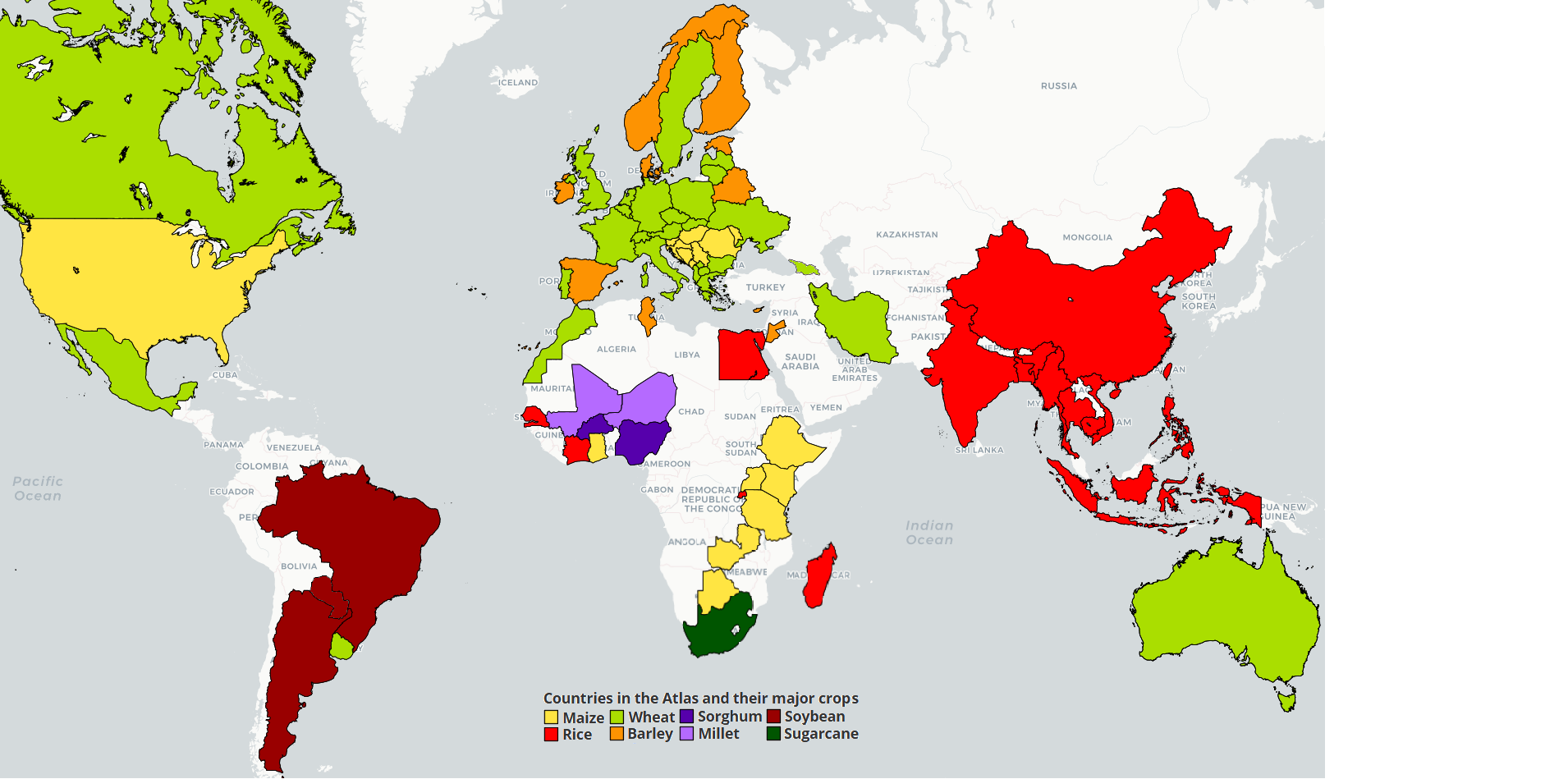 China Wheat
China Wheat
Wheat production in China
Since 1991, China has been one of the top wheat producer in the world (Figure 1). A tremendous progress has been achieved in China's wheat production with average yields increased from less than 1 t ha-1 in 1949 to 5 t ha-1 in 2013, and a total production of 126 Mt in 2014 (Qin et al., 2015). The wheat-growing regions of China are divided into three major agro-ecological zones: northern China winter wheat region, southern China winter wheat region, and southern China spring wheat region. The northern winter wheat region is the most important wheat-producing area, with 60 to 70% of the total wheat production in China, followed by the southern winter wheat region with 25% (He, 2001).
Data Sources and Assumptions (following GYGA protocols) for wheat in China
Harvested area
Harvested area of irrigated and rainfed wheat were retrieved from SPAM2000 (http://mapspam.info/). For the actual yield disaggregation by water regime, SPAM2010v2 was used.
Weather data and reference weather stations (RWS)
In total, 22 RWSs in irrigated areas and 40 RWSs in rainfed areas were selected following the GYGA protocols (Grassini et al., 2015; van Bussel et al., 2015). The buffer zones of the designated RWSs cover 46% (rainfed) and 48% (irrigated) of the wheat national harvested area. The irrigated RWSs belong to 11 climate zones while the rainfed RWSs belong to 22 climate zones.
Weather data for 10 years (2008-2017), including maximum and minimum temperatures, sunshine hours, wind speed, relative humidity and precipitation were collected from the Chinese Meteorological Administration. The solar radiation was calculated with sunshine hours following the Angstrom equation.
Actual yields
Data of actual yield were collected from statistical yearbooks in each province. Data were collected for 10 years (2008-2017) in the counties where the selected RWS were located. The original wheat data did not make the distinction between irrigated and rainfed wheat. In order to disaggregate the actual yields by water regime we applied the following protocol. Within each RWS buffer zone if the percentage of harvested area for irrigated wheat was:
- Higher than 75% it was assumed actual yield represented only irrigated wheat and thus rainfed wheat was not considered for that buffer zone.
- Less than 25%, it was assumed actual yield represented only rainfed wheat and thus irrigated wheat was not considered for that buffer zone.
- In all over cases, the distinction between rainfed and irrigated yield was made using expert opinion. Local experts provided the ratio between irrigated and rainfed yield (r = Yairrigated / Yarainfed). Letting Ya denote actual yield as initially collected and assuming that Ya was the result of a simple arithmetical mean between irrigated (Yairrigated) and rainfed actual yields (Yarainfed), Yairrigated and Yarainfed were derived as follows: Yarainfed = 2Ya / (1 + r); Yairrigated = r x Yarainfed .
Model calibration
Ceres-Wheat was used to simulate Yp and Yw, wchich is one of the modular structures in the decision support system for agrotechnology transfer (DSSAT) crop system model (Godwin et al., 1990; Ritchie and Otter, 1985; Ritchie et al., 1988). DSSAT47 was used in this study. The generalized likelihood uncertainty estimation (GLUE) was used to estimate the parameter values (Table 1) to make the simulation results tailored to the specific crop and environmental conditions in the different regions of China. Two cultivars were calibrated for irrigated wheat, Liangxing99 in North China Plain and Xiaoyan22 in Northwest China. Also, two cultivars were calibrated for rainfed wheat, Liangxing99 in North China Plain and Changhan58 in Northwest China. Wheat cultivar parameters in Southern China are available in Lv et al., 2017.
Table 1 Genetic coefficients of wheat obtained through the DSSAT-GLUE package
| Parameter | Unit | Definition |
| P1V | days | Days at optimum vernalizing temperature required to complete vernalization. |
| P1D | – | Percentage reduction in development rate in a photoperiod 10 hour shorter than the threshold relative to that at the threshold. |
| P5 | – | Grain filling (excluding lag) phase duration. |
| G1 | #/g | Kernel number per unit canopy weight at anthesis. |
| G2 | mg | Standard kernel size under optimum conditions. |
| G3 | g | Standard, non-stressed dry weight (total, including grain) of a single tiller at maturity. |
| PHINT | ℃ day | Interval between successive leaf tip appearances. |
Soil data
Soil data was retrieved from the literature (Zhang et al, 2005 ; Zhang et al, 2006 ; Zhuo et al, 2015) and expert opinion. Deviating from the classic GYGA protocol, simulations were carried out using the most important soil type per buffer zone.
Wheat management practices
Wheat management data included planting date, planting density, growth duration, etc. All these data were collected from the local experts and published papers (Ji et al., 2014; Li et al., 2012; Lu et al., 2015) in each CZ.
References
Godwin D, Ritchie J, Singh U, Hunt L. 1990. A User’s Guide to CERES-Wheat v2.1, 2nd ed. International Fertilizer Development Center, Muscle Shoals, AL.
Grassini P, van Bussel LGJ, Van Wart J, Wolf J, Claessens L, Yang H, Boogaard H, de Groot H, van Ittersum MK, Cassman KG. 2015. How good is good enough? Data requirements for reliable crop yield simulations and yield-gap analysis. Field Crops Research, 177: 49-63.
Ji J, Cai H, He J, Wang H. 2014. Performance evaluation of CERES-Wheat model in Guanzhong Plain of Northwest China. Agricultural Water Management, 144: 1-10
Ritchie JT, Godwin DC, Otter-Nacke S. 1988. CERES-Wheat: A Simulation Model of Wheat Growth and Development. Texas A&M Univ. Press, College Station.
Ritchie JT, Otter S. 1985. Description and performance of CERES-Wheat: a user oriented wheat yield model. ARS wheat yield project. ARS-38. Natl. Tech. Inf. Serv., Springfield, VA, pp. 159–175.
Li H, Liu L, Wang Z, Yang J, Zhang J. 2012. Agronomic and physiological performance of high-yielding wheat and rice in the lower reaches of Yangtze River of China. Field Crops Research, 133: 119-129.
Lv ZF, Liu, XJ, Cao, WX , Zhu, Y. 2017. A Model-Based Estimate of Regional Wheat Yield Gaps and Water Use Efficiency in Main Winter Wheat Production Regions of China. Scientific Reports, 7:6081
Lu D, Lu F, Pan J, Cui Z, Zou C, Chen X, He M, Wang Z. 2015. The effects of cultivar and nitrogen management on wheat yield and nitrogen use efficiency in the North China Plain. Field Crops Research, 171: 157-164.
van Bussel LGJ, Grassini P, Van Wart J, Wolf J, Claessens L, Yang H, Boogaard H, de Groot H, Saito K, Cassman K G, van Ittersum M K. 2015. From field to atlas: Upscaling of location-specific yield gap estimates. Field Crops Research, 177: 98-108.
Zhang SL , Lövdahl L, Grip H, Tong YN. 2006. Soil hydraulic properties of two loess soils in China measured by various field-scale and laboratory methods. Catena, 69: 264–273.
Zhang XC , Liu WZ . 2005. Simulating potential response of hydrology, soil erosion, and crop productivity to climate change in Changwu tableland region on the Loess Plateau of China. Agricultural and Forest Meteorology, 131: 127–142.
Zhuo TL , Yang JY , Drury CF , Hoogenboom G. 2015. Evaluation of the DSSAT-CSM for simulating yield and soil organic C and N of a long-term maize and wheat rotation experiment in the Loess Plateau of Northwestern China. Agricultural Systems 135: 90–104.
Get access to the Atlas for advanced users
Download GYGA results
 | Please read the license information in case you are interested in using the data from the Global Yield Gap Atlas. |
| read more>> |
 Country agronomist
Country agronomist

Baohua Liu
Sino-French Institute for Earth System Science, College of Urban and Environmental Sciences, Peking University, Beijing

